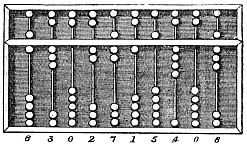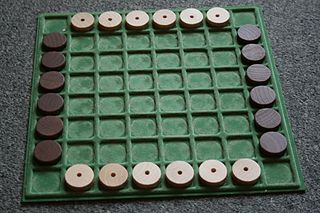
The abacus, also called a counting frame, is a calculating tool which has been used since ancient times. It was used in the ancient Near East, Europe, China, and Russia, centuries before the adoption of the Arabic numeral system. The exact origin of the abacus has not yet emerged. It consists of rows of movable beads, or similar objects, strung on a wire. They represent digits. One of the two numbers is set up, and the beads are manipulated to perform an operation such as addition, or even a square or cubic root.

Backgammon is one of the oldest known board games. Its history can be traced back nearly 5,000 years to archaeological discoveries in Jiroft, modern-day Iran. It is a two-player game where each player has fifteen pieces that move between twenty-four triangles (points) according to the roll of two dice. The objective of the game is to be first to bear off, i.e. move all fifteen checkers off the board. Backgammon is a member of the tables family of games, one of the oldest classes of board games.

Sternhalma, commonly known as Chinese checkers or Chinese chequers, is a strategy board game of German origin which can be played by two, three, four, or six people, playing individually or with partners. The game is a modern and simplified variation of the game Halma.

Xiangqi, also called Chinese chess or Elephant chess, is a strategy board game for two players. It is one of the most popular board games in China, and is in the same family of games as Western chess, chaturanga, shogi, Indian chess and janggi. Besides China and areas with significant ethnic Chinese communities, xiangqi is also a popular pastime in Vietnam, where it is known as cờ tướng.
Chess strategy is the aspect of chess play concerned with evaluation of chess positions and setting of goals and long-term plans for future play. While evaluating a position strategically, a player must take into account such factors as the relative value of the pieces on the board, pawn structure, king safety, position of pieces, and control of key squares and groups of squares. Chess strategy is distinguished from chess tactics, which is the aspect of play concerned with the move-by-move setting up of threats and defenses. Some authors distinguish static strategic imbalances, which tend to persist for many moves, from dynamic imbalances, which are temporary. This distinction affects the immediacy with which a sought-after plan should take effect. Until players reach the skill level of "master", chess tactics tend to ultimately decide the outcomes of games more often than strategy does. Many chess coaches thus emphasize the study of tactics as the most efficient way to improve one's results in serious chess play.

Draughts or checkers is a group of strategy board games for two players which involve diagonal moves of uniform game pieces and mandatory captures by jumping over opponent pieces. Draughts developed from alquerque. The name 'draughts' derives from the verb to draw or to move, whereas 'checkers' derives from the checkered board which the game is played on.

Connect Four is a two-player connection board game, in which the players choose a color and then take turns dropping colored discs into a seven-column, six-row vertically suspended grid. The pieces fall straight down, occupying the lowest available space within the column. The objective of the game is to be the first to form a horizontal, vertical, or diagonal line of four of one's own discs. Connect Four is a solved game. The first player can always win by playing the right moves.

The suanpan, also spelled suan pan or souanpan) is an abacus of Chinese origin first described in a 190 CE book of the Eastern Han Dynasty, namely Supplementary Notes on the Art of Figures written by Xu Yue. However, the exact design of this suanpan is not known. Usually, a suanpan is about 20 cm tall and it comes in various widths depending on the application. It usually has more than seven rods. There are two beads on each rod in the upper deck and five beads on each rod in the bottom deck. The beads are usually rounded and made of a hardwood. The beads are counted by moving them up or down towards the beam. The suanpan can be reset to the starting position instantly by a quick jerk around the horizontal axis to spin all the beads away from the horizontal beam at the center.

Fields of Action is an abstract strategy board game for two players.

English draughts or checkers, also called American checkers or straight checkers, is a form of the strategy board game draughts. It is played on an 8×8 chequered board with 12 pieces per side. The pieces move and capture diagonally forward, until they reach the opposite end of the board, when they are crowned and can thereafter move and capture both backward and forward.

The Game of the Generals, also called GG or GOG as it is most fondly called, or simply The Generals, is an educational war game invented in the Philippines by Sofronio H. Pasola Jr. in 1970. Its Filipino name is "Salpakan." It can be played within twenty to thirty minutes. It is designed for two players, each controlling an army, and a neutral arbiter to decide the results of "challenges" between opposing playing pieces, that like playing cards, have their identities hidden from the opponent.

Russian draughts is a variant of draughts (checkers) played in Russia and some parts of the former USSR, as well as parts of Eastern Europe and Israel.
Italian Damone is a two-player abstract strategy board game from Italy. It belongs to the draughts (checkers) family, and it is specifically a diagonal checkers variant. Each player's pieces are initially placed on two opposite corners of the board and move towards the opposite corner with the possibility of promotion for most of its pieces. The flow of the game is generally between these two opposite corners hence the diagonality of the game. Each player only has eight pieces to start the game, which is relatively small compared to most checker variants. Unlike the undifferentiated pieces as found in most checker variants at the beginning of the game, the pieces in Italian Damone are already differentiated by rank. The pieces are ranked from high to low as Damone, Damas, and Pedine. The Damone is sometimes referred to as Imperatore. The standard game has 1 Damone, 2 Damas, and 5 Pedines for each player. A player's piece can only capture an opposing piece if the opposing piece is the same rank or lower; therefore, it cannot capture a higher ranked piece.

Lines of Action is an abstract strategy board game for two players invented by Claude Soucie. The objective is to connect all of one's pieces into a single group.
Connect 4x4 is a three-dimensional-thinking strategy game first released in 2009 by Milton Bradley. The goal of the game is identical to that of its similarly named predecessor, Connect Four. Players take turns placing game pieces in the grid-like, vertically suspended playing field until one player has four of his or her color lined up horizontally, vertically, or diagonally. Unlike its predecessor, Connect 4x4 uses a double grid, two different types of game pieces, and can be played by up to four people at once.

The following outline is provided as an overview of and topical guide to chess:
This page explains commonly used terms in board games in alphabetical order. For a list of board games, see List of board games. For terms specific to chess, see Glossary of chess. For terms related to chess problems, see Glossary of chess problems.

Poddavki, also known as Giveaway checkers, Suicide checkers, Anti-checkers or Losing draughts is a draughts (checkers) game based on the rules of Russian draughts, with the variation that a player wins if they have no legal moves on their turn, either by giving up all their pieces or having them all blocked. As in most varieties of draughts, capturing is mandatory. The game is played in Russia and some parts of the former Soviet Union.

Bashni, also known as column draughts, multi-level checkers, and rarer Chinese checkers, is a variation of draughts, known in Russia since the 19th century. The game is played according to the basic rules of Russian draughts, with the main difference being that draughts being jumped over are not removed from the playing field but are instead placed under the jumping piece . The resulting towers move across the board as one piece, obeying the status of the upper draught. When a tower is jumped over, only the upper draught is removed from it. If, as a result of the combat, the top draught changes colour, ownership of the tower passes on to the opposing player. Based on Bashni, but according to the basic rules of English draughts, world chess champion Emanuel Lasker developed the draughts game "Laska" and, in 1911, published its description. Lasker described towers that can only be "double-layered": i.e. there can be no alternation of colors. He also showed that during the game the number of game pieces either remains constant or decreases. Column draughts are a subject of interest for the mathematical Sciences: combinatorics, theory of paired zero-sum games, etc.













